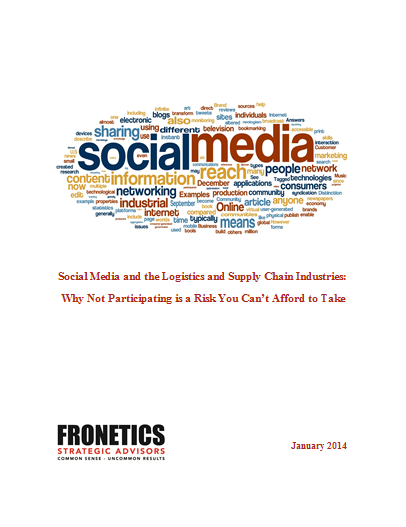
by Fronetics | Sep 16, 2014 | Blog, Content Marketing, Marketing, Social Media, Strategy, Supply Chain

I work with companies from the supply chain and logistics industries to identify and execute strategies that will grow their business. Too often I see companies who have invested time and money into developing a B2B inbound marketing strategy and have fallen flat. Here are six reasons why inbound marketing strategies tend to fail:
The ideal customer is not being targeted
A successful inbound marketing strategy will attract and engage the “right people” – ideal customers. It is therefore essential that time is taken to understand who the ideal customer is, the needs of the customer, and the customer’s pain points. Your company’s website, social media presence, and email communications, should speak to your ideal customer.
Content is not published consistently
A common pitfall is establishing a blog, but only publishing content on a sporadic basis. To establish your company as an industry leader and gain leads, you need to publish content on a consistent basis. For example, your company needs to commit to publishing blog content every Tuesday.
Content is not quality content
All content is not equal. If you want your inbound marketing efforts to succeed, your content needs to be quality content. Your content should be well-researched, sourced, and edited. Grammatical errors and misspellings are inexcusable.
More isn’t always better
It is easy to sign up for a social media account. I’ve seen many companies who have decided to jump into social media feet first and have established many social media accounts, only to become overwhelmed. If you want your inbound marketing strategy to succeed, it is more important to be active on one social network than inactive on five.
Lack of strategy and commitment
A 2014 study of B2B marketers found that companies that have a strategy in place are more likely to consider their efforts effective than companies that do not have a stated strategy in place. Companies that do not have a strategy in place, and who do not have someone in charge of the strategy tend to fail.
A focus on sales
Content that informs and educates attracts and engages. Content that is “salesy” not only fails to attract and engage, it turns customers away.
Is your inbound marketing strategy falling flat? Assess your strategy – honestly. Has your company fallen prey to these common pitfalls?

by Fronetics | Sep 9, 2014 | Blog, Marketing, Social Media, Strategy, Supply Chain

Many companies within the supply chain industry do not participate in social media because “they can’t get past the word ‘social’ and the perception it creates.” Companies with this mindset are at a disadvantage.
The supply chain industry is, by nature, an industry that is built on relationships, partnerships, cooperation, networks, and on communication. Being social is vital to the success of companies with the supply chain industry. Social media is a platform that is well poised to meet the needs and demands of the supply chain industry – and to help companies within the industry grow their business.
Social media is a tool that can be used be the supply chain industry for: risk management, business intelligence, recruitment, lead generation, engaging with current and prospective customers, attracting new customers, improving productivity, problem solving, and establishing your company as an industry leader. Moreover, social media can be used as the foundation for a new business model.
Clara Shih, CEO and Founder of Hearsay Social, and Lisa Shalett, Managing Director and Head of Brand Marketing and Digital Strategy at Goldman Sachs, write:
Social media is perhaps best thought of as a set of new and innovative ways for businesses and customers to do what they have always done: build relationships, exchange information, read and write reviews, and leverage trusted networks of friends and experts.
Similarly, Tony Martins, President of Tony Martins & Associates, notes that:
Supply chain executives should look at the social model of collaboration that can be enabled through social media as the most significant strategic weapon in supply chain optimization today. It liberates them from the rigid framework of functional structures and client-supplier relationships. It is the best way I’ve seen to keep the supply chain moving quickly, in spite of the many problems that will always occur.
Still skeptical? Look at companies who have successfully leveraged social media. Or, as Shih and Shalett suggest: “As you contemplate the risks and rewards of social media, we would suggest that the key ingredient for evaluation is simply to experience it for yourself.”
Interested in learning more about social media and the supply chain industry? Download our white paper: “Social Media and the Logistics and Supply Chain Industries: Why Not Participating is a Risk You Can’t Afford to Take.”

by Fronetics | Aug 14, 2014 | Blog, Marketing, Social Media, Strategy, Supply Chain
We want to hear from you! 
We want to know what questions you have about:
- Demand generation
- Establishing and growing an online presence
- Social media
- Content
These categories are intentionally broad because we want to you to think about any (and all) questions and pain points you might have related to these topics.
Remember the adage – there is no stupid question.
Why do we want to hear from you?
We have an upcoming series of blog posts that are focused on answering questions that companies within the supply chain industry have regarding demand generation, an online presence, social media, and content. We want to give you the opportunity to ask your questions and state your challenges so that your questions and challenges can be addressed.
How can you be heard?
Fill out the form below or content with us via Twitter or LinkedIn.

by Fronetics | Aug 14, 2014 | Blog, Marketing, Social Media, Strategy, Supply Chain
We want to hear from you! 
We want to know what questions you have about:
- Demand generation
- Establishing and growing an online presence
- Social media
- Content
These categories are intentionally broad because we want to you to think about any (and all) questions and pain points you might have related to these topics.
Remember the adage – there is no stupid question.
Why do we want to hear from you?
We have an upcoming series of blog posts that are focused on answering questions that companies within the supply chain industry have regarding demand generation, an online presence, social media, and content. We want to give you the opportunity to ask your questions and state your challenges so that your questions and challenges can be addressed.
How can you be heard?
Fill out the form below or content with us via Twitter or LinkedIn.

by Fronetics | Aug 13, 2014 | Blog, Marketing, Social Media, Strategy, Supply Chain
Leads are essential to the growth of your business. Social media is an effective way to find new leads.
Social media allows you to find new leads by doing something called social prospecting. Social prospecting is the art of searching the social web, identifying potential prospects for your business, and engaging them in a manner that draws them to your company’s website and through your funnel.
Social prospecting
At the core, social prospecting is about listening. It is about listening to social media conversations in order to generate leads for your business. It’s beyond monitoring keywords. It’s about engaging people that may or may not know what your business can do for them.
Workbook
We’ve identified the quickest way to find potential prospects on Twitter, Facebook, LinkedIn, Pinterest, and Google+ and compiled them in a workbook. Every worksheet includes: a short preparatory work to make the actual prospecting easy; visual instructions on how and where to find prospects; pro tips that will help you get the best results; prescriptions (Marketing Rx) for success; and take-home exercises for follow-up prospecting
Get started
Want to get started? Simply download the workbook.


by Fronetics | Aug 13, 2014 | Blog, Marketing, Social Media, Strategy, Supply Chain
Leads are essential to the growth of your business. Social media is an effective way to find new leads.
Social media allows you to find new leads by doing something called social prospecting. Social prospecting is the art of searching the social web, identifying potential prospects for your business, and engaging them in a manner that draws them to your company’s website and through your funnel.
Social prospecting
At the core, social prospecting is about listening. It is about listening to social media conversations in order to generate leads for your business. It’s beyond monitoring keywords. It’s about engaging people that may or may not know what your business can do for them.
Workbook
We’ve identified the quickest way to find potential prospects on Twitter, Facebook, LinkedIn, Pinterest, and Google+ and compiled them in a workbook. Every worksheet includes: a short preparatory work to make the actual prospecting easy; visual instructions on how and where to find prospects; pro tips that will help you get the best results; prescriptions (Marketing Rx) for success; and take-home exercises for follow-up prospecting
Get started
Want to get started? Simply download the workbook.







